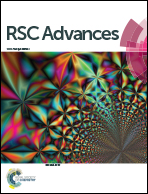Allantoin-loaded porous silica nanoparticles/polycaprolactone nanofiber composites: fabrication, characterization, and drug release properties†
Abstract
The development of biocompatible nanocomposites for biomedical applications such as drug release has attracted increasing attention in recent years. We report porous silica nanoparticles (PSNs) immobilized polycaprolactone (PCL) nanofiber composites (PCL/PSNs) for drug delivery applications. The allantoin (model drug)-loaded PSNs were mixed well with a PCL solution and electrospun to fabricate the PCL/PSNs nanofiber composites. The PSNs were prepared from rice husk. Allantoin was loaded on the PSNs to prepare (allantoin-PSNs), and its three different concentrations (10, 20 and 30 wt%) based on PCL wt% were chosen. The biocompatibility and biodegradability of PCL, higher adsorption and nontoxicity of mesoporous silica nanoparticles and the promising results of the PCL/PSNs composite highlighted their challenging potential for controlled drug delivery applications. The prepared PSNs, PCL nanofibers and PCL/allantoin-PSNs nanofiber composites were characterized by scanning electron microscopy-energy dispersive spectroscopy (SEM-EDS), transmission electron microscopy (TEM), X-ray diffraction (XRD), X-ray photoelectron microscopy (XPS), Fourier transform infrared (FTIR) spectroscopy, and drug release analysis. The results confirmed the successfully synthesis of mesoporous nanoscopic PSNs from rice husk and controlled allantoin release profile by the resulting PCL/allantoin-PSNs nanofiber composites.


 Please wait while we load your content...
Please wait while we load your content...